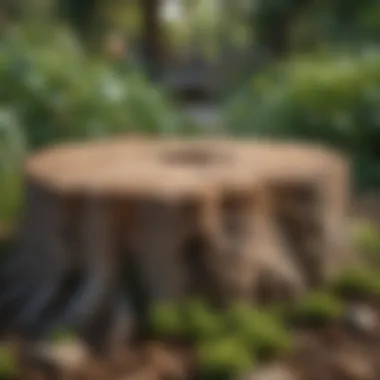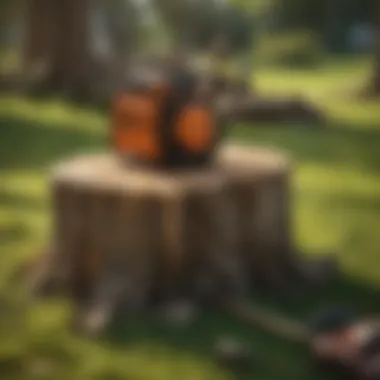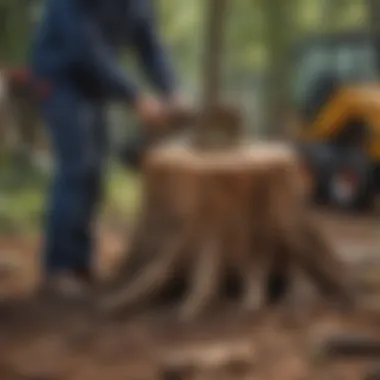Strategies for Eliminating Tree Stumps: A Comprehensive Guide


Intro
Tree stumps can be an eyesore in any yard, disrupting the landscape and making it difficult to engage in outdoor activities or landscaping projects. Their removal is often essential for creating a clean and functional space. This guide will discuss various strategies for eliminating tree stumps that cater to homeowners and gardening enthusiasts alike. From manual techniques to chemical treatments and professional services, there are numerous ways to approach this task. Each method has its own advantages and disadvantages, which we will explore in detail.
Understanding these different approaches can help you make informed decisions about what is best for your particular situation. Whether you are looking to enhance your backyard, prepare for new planting, or simply want to improve the aesthetic appeal of your home, knowing the options available is crucial.
"Removing tree stumps is not just about aesthetics; it can also improve safety and enhance property value."
In this comprehensive guide, we will cover key points such as the relevant manual techniques, the effectiveness of chemical treatments, and the considerations for hiring professionals. By the end of this article, you will have a clear understanding of how to tackle tree stump removal in your own yard.
Prolusion to Tree Stump Removal
Tree stump removal is a crucial concern for many homeowners and gardening enthusiasts alike. Once a tree is cut down, the remaining stump can pose multiple problems in both appearance and functionality of the landscape. Understanding how to effectively remove tree stumps becomes essential to maintaining an attractive and safe outdoor space.
The presence of a stump can detract from the overall aesthetics of a yard. It interferes with landscaping designs, especially when planning for new flower beds or pathways. Additionally, stumps can become a breeding ground for pests, including insects and fungi, which can further compromise the integrity of nearby plants.
Moreover, safety is a significant consideration in stump removal. A protruding stump can be a tripping hazard, particularly for children and pets. In wet conditions, surfaces around the stump can become muddy and slippery, exacerbating the risk of accidents. Thus, promptly addressing stump removal contributes to a safer environment.
In this guide, we aim to explore various strategies for tree stump removal, covering manual, chemical, and professional methods. Each approach has its unique benefits and challenges, depending on the specific circumstances of the landscape. By gaining insight into these methods, readers can make informed decisions tailored to their individual needs. Removing tree stumps not only enhances the visual appeal of a yard but also opens up new possibilities for landscaping and plant growth.
Understanding the Need for Tree Stump Removal
Tree stumps can appear as mere remnants of fallen trees, but their presence carries implications that extend beyond a simple eyesore in the yard. Understanding the necessity of their removal involves examining multiple facets including aesthetics, safety risks, and potential landscaping advantages. Each of these elements contributes to why homeowners should consider this task a vital part of property maintenance.
Aesthetic Considerations
The visual element of any outdoor space plays a significant role in its overall appeal. Tree stumps disrupt the smooth flow of a landscape. They can detract from the beauty of gardens and lawns, which many homeowners invest time and resources to nurture. A well-maintained yard often reflects the personal touch of its owner. Leaving stumps can convey neglect or a lack of care, impacting not just the homeowner's satisfaction but also property value.
When tree stumps are removed, the area can be replanted or redesigned, allowing for greater flexibility in landscaping choices. Removing them can enhance the unity of the property while facilitating more attractive options for garden layout. Overall, addressing tree stumps should be seen as a critical step in achieving landscaping goals.
Safety Concerns
Beyond aesthetics, tree stumps present tangible safety hazards. Unattended stumps can pose risks to children, pets, and visitors. Tripping accidents are common, especially in yards where play and activity take place. Additionally, stumps can become hosts for pests or fungi, which may lead to larger issues such as insect infestations or potential diseases.
Another point to consider is that stumps might form an obstruction during regular yard maintenance. Lawn mowers and other equipment can sustain damage while navigating around them, resulting in costly repairs. Keeping the yard safe and functional should be a priority for any homeowner, and addressing tree stumps is an essential component of that responsibility.
Landscaping Opportunities
Removing tree stumps opens a variety of possibilities for garden enhancement and functionality. Once stumps are eliminated, homeowners can implement new planting schemes, landscape designs, or even outdoor features such as patios or pathways. These opportunities for renewal can transform previously wasted space into functional and visually pleasing areas.
Whether adding small ornamental trees, colorful flowers, or creating a vegetable garden, the options become limitless. This process not only rejuvenates the landscape but may also add value to the property. A yard that accommodates diverse plantings can attract more wildlife, supporting local ecosystems. The removal of tree stumps is not merely about clearing obstacles; it is about embracing potential for growth and sustainability in the outdoor environment.
Manual Methods for Tree Stump Removal
Manual methods for tree stump removal hold significant relevance in this guide. They offer homeowners a chance to tackle the problem directly, providing a sense of accomplishment when completed. These methods require physical effort and can be time-consuming, but they are often more cost-effective than hiring professionals or using machinery. Understanding various manual techniques allows readers to choose an option that aligns with their skills, comfort, and the specific situation of their yard.
Digging Out the Stump
Tools Required
The tools required for digging out a tree stump play a crucial role in the process. Key tools include a shovel, axe, rake, and possibly a saw. Each tool serves a specific purpose, such as cutting roots or loosening soil. Using the right tools can make the task easier and more effective. A shovel, for instance, is essential for removing soil around the stump, while an axe may be necessary for severing stubborn roots. However, reliance on manual tools does present some disadvantages, notably the physical strain on the body and the time invested in the task.
Step-by-Step Instructions
The step-by-step instructions for digging out a stump add structure and clarity to the removal process. This method involves a systematic approach—starting with lowering the soil around the stump, cutting exposed roots, and finally, pulling the stump from the ground. By providing clear steps, homeowners can follow along, reducing the risk of missing crucial actions or becoming overwhelmed. However, if the stump is large or deeply rooted, this method may require an extensive investment of time and effort, which should be considered before beginning.
Post-Removal Care


Post-removal care is essential after the stump is out of the ground. This process can include filling the hole with soil, adding compost, or using the area for new plantings. Proper care ensures that the site remains stable and usable. It's important to note that leaving the hole unattended can lead to soil erosion or become a habitat for pests. Thus, addressing this area promptly after removal is beneficial to maintain the aesthetic of the yard and prevent future issues.
Using a Stump Grinder
Choosing the Right Grinder
Choosing the right grinder is key for those opting to use machinery for stump removal. Factors to consider include the size of the stump and the access to the area. A well-selected grinder can make the process swift and efficient, saving time compared to manual removal. For instance, smaller grinders might suffice for compact stumps, while larger ones are essential for bigger trees. However, not all homeowners may feel comfortable using such equipment, requiring a basic understanding of its functionality.
Safety Precautions
Safety precautions are vital when operating a stump grinder. Protective gear such as goggles and gloves is essential to avoid injury. Additionally, understanding the machine's operating manual can prevent accidents. A nimble approach to safety ensures not just effective use of the equipment but also minimizes potential dangers associated with handling machinery. The downsides are often the need for additional training or experience if unfamiliar with such equipment.
Operational Guidelines
Operational guidelines provide a framework for using a stump grinder correctly. Each guideline ensures the grinder is used in a way that maximizes efficiency while minimizing risk. Properly positioning the grinder and selecting the right depth for cutting are crucial elements of this process. While these guidelines enhance the likelihood of successful removal, they can also require careful adherence. Ignoring operational guides could lead to ineffective stump removal or even damage to the surrounding landscape.
Chemical Methods for Tree Stump Removal
Chemical methods for removing tree stumps offer a variety of practical solutions, especially when manual methods prove impractical or overly labor-intensive. Utilizing chemicals provides an efficient alternative to physical removal. The effectiveness of these methods can also minimize the time required to eliminate unsightly stumps while loosening soil for future landscaping.
With the growing popularity of eco-friendly practices, many people question the environmental impact of using chemicals in their yards. This section presents a detailed analysis of chemical stump removal methods, their applications, and the considerations involved.
Herbicides and Their Application
Types of Herbicides
Herbicides specifically designed for tree stump removal contain chemicals that accelerate the decay of the wood. Among the most well-known types are glyphosate-based herbicides, which work by targeting the plant's growth systems. Another effective option is Triclopyr, which disrupts hormone systems in woody plants, yielding quicker results.
Understanding these types is essential for homeowners aiming for efficient stump removal. Glyphosate is often favored due to its widespread availability and effectiveness. However, Triclopyr is recommended for more stubborn stumps that might resist other chemicals. Recognizing these differences allows better decision-making in selecting the right herbicide.
Application Techniques
The application technique plays a crucial role in the effectiveness of herbicides. There are several methods, such as cutting the stump and applying the herbicide directly onto the fresh cut, or drilling holes into the stump to allow better absorption.
A direct application is advantageous because it ensures that the chemical penetrates deeply into the living tissue of the stump. However, drilling can increase the herbicide's effectiveness by enhancing absorption capabilities. Understanding these techniques can help enhance the efficiency of chemical stump removal.
Environmental Considerations
When choosing chemical methods, understanding their potential environmental impact is paramount. Herbicides can seep into the ground and affect surrounding plants and wildlife. As such, careful application is essential. Choosing the right moment, such as avoiding rainy days, can prevent runoff and reduce harm to the local ecosystem.
Considering eco-friendly herbicides can also be beneficial. Many manufacturers now offer products that minimize environmental impact while providing effective results. Evaluating the chemical’s safety ensures the protection of your garden and local wildlife during the stump removal process.
Homemade Chemical Solutions
Ingredients Needed
Creating homemade solutions for stump removal can be a cost-effective alternative. Common ingredients include salt, vinegar, and baking soda. These substances can break down the wood over time and are generally safer for the environment compared to commercial herbicides.
By using accessible ingredients, homeowners can create mixtures that prove effective against stubborn stumps. Homemade solutions are also appealing due to their low cost and minimal environmental impact, making them a popular choice for many.
Effectiveness and Safety
The effectiveness of homemade solutions may vary. Salt and vinegar, for instance, can dry out the stump and inhibit new growth. However, patience is often required as these methods may take longer to produce results compared to synthetic herbicides. Safety can be a concern if used excessively, as high salt content can harm surrounding soil.
Utilizing homemade solutions encourages responsible gardening by minimizing chemical exposure, making it an attractive option for those mindful of environmental health.
Long-Term Impacts


The long-term impacts of using homemade chemical solutions should be considered. While they may be effective, the breakdown process can leav the soil quality altered. Seasons may pass before visible results appear. Therefore, understanding the time frame involved in using these methods is beneficial for planning future planting or landscaping projects.
Homemade solutions tend to be less harmful long-term, allowing for sustainable gardening practices. This shift towards natural solutions resonates well with a growing audience of homeowners interested in minimizing chemical use.
Natural Methods for Tree Stump Removal
Natural methods for tree stump removal offer eco-friendly alternatives that effectively address the problem of unwanted stumps. These strategies often rely on simple ingredients found at home or in local stores, appealing to those who prioritize environmental sustainability. Embracing natural methods can lead to the gradual breakdown of tree stumps without the use of harsh chemicals, benefiting both the garden and the surrounding ecosystem.
Using Epsom Salt
Application Process
The application of Epsom salt involves creating a saturated solution that is poured over the tree stump. This salt contains magnesium and sulfur, which eventually dehydrate the stump. To implement this method, one needs to drill holes into the top of the stump, then fill them with Epsom salt followed by water. This process helps the salt absorb into the wood.
The ease of application makes this method a popular choice for many homeowners. Also, Epsom salt is relatively inexpensive compared to other chemical solutions. However, its effectiveness can be slow, requiring patience as the stump gradually decomposes.
Time Required for Effectiveness
The effectiveness of this method can take several months to a year. This extended timeline is both an advantage and a disadvantage. On one hand, it minimizes immediate environmental impact, allowing nature to take its course. On the other hand, homeowners looking for quick results may find this duration frustrating.
Epsom salt can continue to work in the soil even after the tree stump has been removed, enriching the surrounding area. This slow, steady approach allows for natural soil amendment, supporting the growth of future plants.
Considerations for Surrounding Plants
When using Epsom salt, it is important to consider its interaction with nearby plants. High concentrations of salt, if applied excessively, can affect soil salinity and harm surrounding vegetation. The key characteristic of this method is its gentler nature compared to herbicides, making it a wiser choice in diverse planting scenarios. Homeowners should monitor plants nearby to ensure they are not adversely affected.
Bacterial Acceleration Techniques
Applying Nitrogen-Rich Fertilizer
Applying nitrogen-rich fertilizer accelerates the decomposition process of tree stumps. By introducing more nitrogen into the environment, this method promotes the growth of bacteria and fungi, which break down the wood faster. Simply scattering fertilizer around the stump can also aid in the acceleration of decay.
The unique benefit of this technique is its dual purpose: while targeting the stump, it also nourishes surrounding soil. This balance can enhance nutrient availability for new plant growth. However, it is crucial for homeowners to use fertilizers responsibly to avoid nutrient imbalance in their garden.
Growth of Decomposing Bacteria
The growth of decomposing bacteria contributes significantly to the breakdown of the stump. When combined with nitrogen-rich fertilizer, the fungi thrive and work efficiently to decompose the organic material. These bacteria can be beneficial as they increase soil microbial activity, fostering a healthy ecosystem for future cultivation.
Yet, results may vary based on environmental factors such as temperature and moisture. Higher temperatures can enhance bacterial activity, making it essential to consider seasonal conditions.
Monitoring Progress
Regular monitoring of the stump’s decomposition process is vital. Homeowners should check periodically for signs of decay, such as softening of the wood and increased insect activity. Monitoring is simple and requires minimal effort but offers valuable insight into the progress of the removal strategy.
Regular checks can help determine whether adjustments to the method are necessary, making this a proactive approach.
Overall, natural methods such as using Epsom salt and bacterial acceleration techniques provide reliable and environmentally friendly options for tree stump removal. Homeowners can embrace these methods for a well-maintained garden while promoting sustainable practices.
Hiring Professional Stump Removal Services
Removing a tree stump can be labor-intensive and require specialized equipment. Hiring a professional stump removal service can save time and ensure the job is done properly. Professionals have experience and tools that most homeowners lack. This section explores key elements to consider when hiring a service provider.
Evaluating Service Providers
Credentials and Certifications
When selecting a stump removal service, it is vital to check the credentials and certifications of the company. These demonstrate that the service provider has undergone the necessary training and possesses the required skills. A properly certified service gives homeowners peace of mind regarding safety and proficiency. Certifications like ISA (International Society of Arboriculture) ensure the company adheres to industry standards. While non-certified companies may offer lower prices, the risks and potential for poor results often outweigh the savings.


Customer Reviews and Testimonials
Customer reviews and testimonials are invaluable resources when evaluating stump removal services. They provide insight into other clients' experiences and satisfaction levels. Positive feedback indicates reliability and quality of work. Websites and platforms, such as Yelp or Facebook, often feature reviews that reflect the general perception of the company. However, it is essential to read a range of reviews to get a balanced view. A high number of favorable reviews compared to complaints can signal good service.
Service Options Offered
Different companies offer various services related to stump removal. It is crucial to investigate what each provider offers. Some may provide additional landscaping services, while others focus strictly on stump grinding and removal. Clarifying these options can lead to better decision-making. Understanding each service's scope helps customers choose the right provider for their specific needs. A company offering comprehensive services may save time and effort for homeowners looking for multiple solutions.
Costs Associated with Professional Services
Factors Affecting Pricing
The cost of stump removal services can depend on several factors. These include the stump size, location, and the removal method utilized. Larger stumps will generally cost more to remove. Accessibility is also a factor; stumps located in difficult or hard-to-reach areas may incur higher costs. Additionally, removal methods, such as grinding versus complete removal, influence pricing. Understanding these factors can help homeowners anticipate expenses realistically.
Comparative Analysis
A comparative analysis of different service providers can reveal significant differences in pricing and services offered. By obtaining quotes from multiple companies, homeowners can identify average costs and spot any unusual pricing. This analysis can also highlight the value offered by each service, ensuring homeowners are not only choosing the cheapest option but one that balances cost and quality.
Budgeting for Stump Removal
Budgeting for stump removal should encompass all related expenses. Homeowners should consider the initial quote as well as potential additional fees, such as disposal charges or site cleanup. Creating a budget gives clarity and helps in making informed decisions.
Understanding these costs and how to plan effectively can ease the process and ensure that homeowners are fully informed before committing to hiring professional services.
Post-Removal Considerations
Removing a tree stump is not the end of the project. Post-removal considerations are crucial for ensuring the area is ready for new use, be it planting, landscaping, or just aesthetics. After a stump removal, it is essential to think about the condition of the soil and what comes next in your garden. This step helps to maximize the potential of your outdoor space.
Preparing the Site for New Plantings
Soil Amendment Techniques
Soil amendment is an important practice after stump removal. This involves modifying the existing soil to improve its nutrient content and structure. The key characteristic of soil amendment is its capacity to revitalize soil health. This is especially essential because soil can be disrupted during stump removal. By amending the soil, you can enhance its drainage and aeration. One popular option is the introduction of organic compost, which contains valuable nutrients. However, it is important to be aware that not all amendments will be suitable for every plant type.
Choosing Appropriate Plants
Choosing plants that thrive in the amended soil is another vital aspect. The right plants will not only survive but also enhance your garden's appeal. Native species are often beneficial as they adapt well to local conditions. Their resilience makes this option a popular choice in landscaping. In addition, selecting plants based on sunlight and moisture preferences ensures optimum growth conditions. However, one must consider that some plants might compete aggressively with each other for resources, potentially leading to a less harmonious garden.
Timing for Replanting
Timing is critical when it comes to replanting. The best period for introducing new plants usually depends on the climate and specific plant needs. Spring or early fall is generally considered advantageous due to favorable weather conditions. The unique feature of timing for replanting is the reduced risk of transplant shock experienced by new plants. However, if plants are put in the ground too late in the season, they may struggle to establish before harsher weather sets in.
Disposal of Stump Debris
Proper disposal of stump debris is also an important post-removal consideration. This often overlooked aspect can influence the overall appearance of the area and local ecology.
Composting Options
Composting the debris is an effective option. It contributes to reducing waste while creating a rich soil amendment for future gardening projects. The key characteristic of composting is its ability to decompose wood matter into nutrient-rich soil. This option is beneficial because it promotes sustainability. However, it may require patience, as decomposing larger pieces could take several months.
Local Regulations
Adhering to local regulations regarding debris disposal is necessary. Different areas may have specific guidelines on how to dispose of organic waste. The key characteristic of these regulations is their aim to protect the environment. Following local laws ensures responsible management of your property. Nevertheless, it can be challenging to keep track of varying regulations, adding to the burden of homeowners.
Repurposing the Material
Lastly, repurposing the stump debris offers creative options. Using the material in landscaping as mulch or decorative features can enhance your garden's look. The unique feature of repurposing is its dual benefits: aesthetics and sustainability. It encourages environmentally friendly practices. However, it is essential to ensure that any reused material does not harbor pests or diseases that could affect new plants.
In summary, considering post-removal factors allows homeowners to create an appealing and functional outdoor space. By preparing the site properly and disposing of debris responsibly, the area can be transformed into a flourishing landscape.
End
In this article, we have explored various methods for tree stump removal. Understanding the importance of efficiently eliminating stumps is crucial for homeowners and gardening enthusiasts. It not only enhances the aesthetic appeal but also mitigates safety concerns and maximizes landscaping opportunities.
Specific Elements
The conclusion emphasizes that each method of tree stump removal, from manual techniques to hiring professionals, has its own set of advantages and considerations. Homeowners need to reflect on their specific circumstances. For instance, while manual methods may save costs, they can be labor-intensive. Conversely, professional services provide expertise but do come at a price.
Benefits
The main benefit arises from applying the knowledge provided throughout the article. Readers become empowered to make decisions based on their unique needs, preferences, and resources. This decision-making process can ultimately lead to a more organized and visually appealing outdoor space.
Considerations
Additionally, the conclusion underscores the significance of post-removal care and site preparation. Ensuring that the area is suitable for new plantings not only fosters growth but also contributes to the overall design of the landscape. Keeping in mind local regulations regarding stump disposal is also important to avoid potential fines.
In summary, the journey towards a stump-free yard is multifaceted. Employing informed strategies will aid in achieving an outdoor environment that aligns with your vision and functionality.







